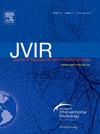在猪模型中使用新型 TIPS 支架移植物创建直径为 6-10 毫米的经颈静脉肝内门体分流术
IF 2.6
3区 医学
Q2 PERIPHERAL VASCULAR DISEASE
Journal of Vascular and Interventional Radiology
Pub Date : 2024-11-10
DOI:10.1016/j.jvir.2024.11.004
引用次数: 0
摘要
目的:在动物模型中评估新型膨胀聚四氟乙烯封装 TIPS 支架移植物("Liverty")的输送、功能和通畅性:在体重为 52-64 千克的猪身上连续制作两组 TIPS:14 个单一装置和 10 个重叠装置。移植时间分别为 30 天(10 个)和 60 天(14 个)。结果:结果:使用不同的人类 TIPS 入路套件,在无并发症的情况下创建了 7 个直径为 6 毫米、5 个直径为 7 毫米和 12 个直径为 10 毫米的 TIPS。一只动物在 35 天时因脑病死亡,其余动物存活至终点。22/24 个 TIPS 在 30 天和 60 天终点时是通畅的;30 天的平均狭窄率为 13.3% +/- 10.1%,60 天的平均狭窄率为 18.44% ± 5.04%。两个分流口因未插入的原肝静脉末端组织增生和向下生长进入 TIPS 而闭塞。组织学和电子显微镜检查显示,整合后的装置内衬光滑、均匀的新内膜组织,平均厚度为 0.48 毫米(单个装置)和 0.74 毫米(重叠装置),前壁炎症极少:结论:新型 Liverty TIPS 支架移植物可直接用于 TIPS 的创建,在单个和重叠配置中均可形成直径为 6、7 和 10 毫米的通畅分流。1个月和2个月的组织学检查显示组织愈合良好,无支架内狭窄。本文章由计算机程序翻译,如有差异,请以英文原文为准。
Creation of 6- to 10-mm-Diameter Transjugular Intrahepatic Portosystemic Shunts Using a Novel Transjugular Intrahepatic Portosystemic Shunt Stent Graft in a Swine Model
Purpose
To assess the delivery, function, and patency of a new expanded polytetrafluoroethylene–encapsulated transjugular intrahepatic portosystemic shunt (TIPS) stent graft (“Liverty”) in an animal model.
Materials and Methods
TIPS were created in 2 successive groups: (a) 14 single and (b) 10 overlapping devices, in swine weighing 52–64 kg. Explants occurred at 30 (n = 10) and 60 (n = 14) days. These were evaluated by histomorphometric and histopathologic evaluations and electron microscopy.
Results
Seven 6-mm-diameter, 5 7-mm-diameter, and 12 10-mm-diameter TIPSs were created using varied human TIPS access sets without adverse events, both sheathed and unsheathed advancement and deployment of the devices within liver tracts. One animal was sacrificed at 35 days due to encephalopathy; the remainder survived to endpoints. Twenty-two of 24 TIPSs were patent at 30-day and 60-day endpoints. The mean stenosis at 30 days was 13.3% (SD ± 10.1), and that at 60 days was 18.4% (SD ± 5.0). Two shunts were occluded by tissue overgrowth at the stent-free native hepatic vein end and downgrowth into TIPS. Histology and electron microscopy showed well-apposed, incorporated devices lined with smooth, uniform neointimal tissue averaging 0.48 mm (single devices) and 0.74 mm (overlapped devices) thick with minimal adventitial inflammation.
Conclusions
The new Liverty TIPS stent graft was straightforward to deploy for TIPS creation and resulted in patent 6-mm-diameter, 7-mm-diameter, and 10-mm-diameter shunts in both single and overlapping configurations. One- and 2-month histology showed desired tissue healing without in-stent stenosis.
求助全文
通过发布文献求助,成功后即可免费获取论文全文。
去求助
来源期刊
CiteScore
4.30
自引率
10.30%
发文量
942
审稿时长
90 days
期刊介绍:
JVIR, published continuously since 1990, is an international, monthly peer-reviewed interventional radiology journal. As the official journal of the Society of Interventional Radiology, JVIR is the peer-reviewed journal of choice for interventional radiologists, radiologists, cardiologists, vascular surgeons, neurosurgeons, and other clinicians who seek current and reliable information on every aspect of vascular and interventional radiology. Each issue of JVIR covers critical and cutting-edge medical minimally invasive, clinical, basic research, radiological, pathological, and socioeconomic issues of importance to the field.

 求助内容:
求助内容: 应助结果提醒方式:
应助结果提醒方式:


